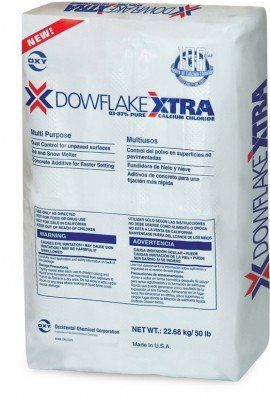DOWFlake for Ice Melting and Dust Control in NJ and Beyond

DOWFlake™
DOWFLAKE™ Xtra 83-87% Calcium Chloride possesses distinctive properties that make it the ideal choice for ice melting, dust control, concrete acceleration and many other applications. Its higher concentration provides a lower application rate than DOWFLAKE™ Xtra releases heat to melt snow and ice faster and across a wider range of temperatures than other materials. Mix it with rock salt, sand and gravel to improve their performance. It reduces dust on unpaved surfaces by absorbing moisture from its surroundings, keeping the surface damp and binding dust particles to the gravel. Adding it to concrete results in reduced time for initial in cold weather. When put into solution, DOWFLAKE™ Xtra is effective in many other applications, including tire weighting brine refrigeration, and as an inert ingredient in pesticide formulations.
HOW ICE MELT WORKS
Ice melt is a crucial tool for winter safety, used to prevent surfaces from icing up and to melt existing ice accumulation. Its effectiveness lies in its ability to alter the chemical composition of water and ice, creating a liquid brine that generates heat and melts the ice. This process disrupts the bond between the ice and the pavement, making it easier to break up and remove.
HOW TO USE ICE MELT FOR DUST CONTROL IN NJ
Ice melt, primarily used for de-icing roads and sidewalks during winter, can also be an effective dust control solution. Its hygroscopic properties attract and retain moisture, binding dust particles and preventing them from becoming airborne. This guide provides detailed instructions and essential tips for using ice melt for various settings needing dust control in NJ.
Ice melt products, typically composed of calcium chloride, magnesium chloride, or sodium chloride, readily absorb moisture from the air. This moisture creates a damp, slightly sticky surface that traps dust particles.
By binding dust particles and weighing them down, ice melt prevents dust from being lifted and carried by wind or traffic. This improves air quality and visibility, and reduces environmental and health hazards associated with dust pollution.
BEST PRACTICES FOR DUST CONTROL IN PA
- Choose the Right Ice Melt: Calcium chloride is generally considered the most effective ice melt for dust control in PA due to its high hygroscopic capacity and long-lasting residual effect.
- Apply at the Right Time: Apply ice melt during periods of low wind and minimal traffic to ensure proper adhesion and prevent dust from being redistributed. Early morning or late evening are often ideal times for application.
- Monitor and Reapply: Regularly inspect the treated area and reapply ice melt as needed to maintain dust control. Frequency of reapplication will depend on weather conditions, traffic volume, and other site-specific factors.
By following these guidelines and best practices, you can effectively use ice melt as a safe and cost-effective dust control solution.


